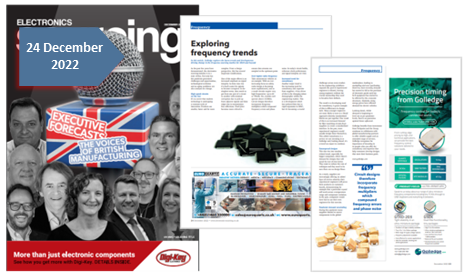As the past few years have demonstrated, the electronics sourcing industry is in a state of flux. Not only has the pandemic generated challenges and opportunities, technological evolution and an aging workforce are also catalysts for change.
High speed circuits on the rise
It’s no secret that modern technology is undergoing a constant cycle of innovation. Products are smaller, faster and far more complex. From a design perspective, this has several important ramifications. One of the major effects is an increased emphasis on signal integrity. As data rates rise it’s much easier for signals to become corrupted. In the simplest terms, data needs to get from one part of a circuit to another with minimal corruption due to pick-up from adjacent signals and false edges due to transmission line reflections. Clock jitter becomes more critical to ensure data streams are sampled at the optimum point.
Ever higher radio frequency
Take autonomous vehicles as an example. With an ever increasing focus on safety, radar design is becoming more sophisticated, and as a result circuits require very high frequencies: up to 60 or 70GHz. Yet, crystals can’t operate above 315MHz. Circuit designs therefore incorporate frequency multipliers which compound frequency errors and phase noise. In today’s circuit builds, reference clock performance and signal integrity are vital.
Increased need for consultancy
Another major trend is the increasing need for consultancy and expertise from suppliers. A key driver of this is the changing talent demographic within the engineering market. This is a development which has surfaced first due to rapid expansion in APAC, but it’s becoming a crucial challenge across every market.
As the engineering workforce expands the pool of experienced engineers is diluted, leaving young engineers without the crucial mentorship they need
to broaden their skillsets.
The result is a developing need for consultancy. A great example of this is differences in design style. Many younger engineers are more likely to turn to a ‘block’ approach whereby standardised blocks are put together. One result of this is an increased demand for filter matching circuits from suppliers to create a standardised interface. In the past, more experienced engineers would usually design these themselves. This added consultancy is a
service we are investing in at Golledge and, looking ahead, it’s a trend we expect to continue.
Futureproof designs
This also ties into another related trend, especially for bigger companies, where there’s demand for designs that will stand the test of time better. They want to reduce the cost of redesigns and they need to be sure there are no design flaws. As a result, suppliers are increasingly offering an added layer of service whereby their experienced engineers will prove their products on customers boards, demonstrating for example that a particular crystal will work across a temperature range and component variation.
In the past, companies would have had to use their own engineers for this exercise. Pandemic demand unwinding During the pandemic many suppliers battled to source components in the global marketplace, leading to stockpiling and over purchasing. However, more recently, demand has started to fall as the purchase of electronic goods such has hi-fi equipment has started to be affected by the economic downturn. Similarly, rising energy prices have affected demand for electric vehicles. Looking ahead, whilst demand is beginning to level out at pre-pandemic levels, there’s no guarantee against future upheaval.
Golledge benefits from investment from Techpoint and the Group continues to collaborate with global manufacturing partners to offer reliable supply and an
extended range of services. Golledge recognises the importance of investing in its people who can offer the consultancy and expertise that help customers develop designs that meet their business goals.
therefore incorporate frequency multipliers which compound frequency errors and phase noise
